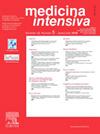Traumatismo penetrante en España: análisis del registro español de trauma en la UCI (RETRAUCI)
IF 3.1
4区 医学
Q2 CRITICAL CARE MEDICINE
引用次数: 0
Abstract
Objective
To describe the epidemiology of penetrating trauma, mortality associated factors and its management in Spanish intensive care units.
Design
Multicenter, prospective registry. A comparison is established between two cohorts defined by the type of trauma (blunt and penetrating).
Patients
Patients with traumatic injury admitted to the participating ICUs from June 2015 to June 2022.
Interventions
None.
Main variable of interest Epidemiology, injury pattern, prehospital and hospital care, resource utilization, and clinical outcomes.
Results
Twelve thousand eight hundred six patients were eligible, of whom 821 (6.4%) suffered penetrating trauma; 418 patients (50.9%) from stab wounds, 93 (11.3%) from gunshot wounds, and 310 (37.8%) from other objects. The most common intent was assault (47.7%). The mean ISS was 15.2 ± 10.6 in penetrating trauma and 19.8 ± 11.9 in blunt trauma (P<.001). ICU mortality was 7.8% compared to 11.7% in blunt trauma, with deaths more frequently occurring within the first 24 hours (64 vs. 39%). Factors associated with mortality included female sex, prior use of antithrombotic agents, older age, higher NISS score, and the presence of cranial trauma or shock.
Conclusions
Penetrating trauma is an emergent pathology in our context with high complexity, highlighting the need for focused study and documentation, protocol development, and resource optimization to provide quality care.
西班牙的普遍创伤:西班牙创伤登记处的分析
目的探讨西班牙重症监护室穿透性创伤的流行病学、死亡相关因素及处理方法。设计多中心,前瞻性注册表。根据创伤类型(钝性和穿透性)确定两个队列之间的比较。2015年6月至2022年6月在icu收治的创伤性损伤患者。流行病学、损伤类型、院前和院前护理、资源利用和临床结果。结果共纳入12886例患者,其中穿透性创伤821例(6.4%);刺伤418例(50.9%),枪伤93例(11.3%),其他伤310例(37.8%)。最常见的意图是攻击(47.7%)。穿透性创伤的平均ISS为15.2±10.6,钝性创伤的平均ISS为19.8±11.9 (p < 0.01)。ICU死亡率为7.8%,而钝性创伤的死亡率为11.7%,死亡更常发生在前24小时内(64%对39%)。与死亡率相关的因素包括女性、既往使用抗血栓药物、年龄较大、较高的NISS评分以及是否存在颅脑外伤或休克。结论穿透性创伤是一种高度复杂的紧急病理,需要重点研究和文献记录,制定方案,优化资源,以提供高质量的护理。
本文章由计算机程序翻译,如有差异,请以英文原文为准。
求助全文
约1分钟内获得全文
求助全文
来源期刊

Medicina Intensiva
CRITICAL CARE MEDICINE-
CiteScore
2.70
自引率
20.00%
发文量
146
审稿时长
33 days
期刊介绍:
Medicina Intensiva is the journal of the Spanish Society of Intensive Care Medicine and Coronary Units (SEMICYUC) and of Pan American and Iberian Federation of Societies of Intensive and Critical Care Medicine. Medicina Intensiva has become the reference publication in Spanish in its field. The journal mainly publishes Original Articles, Reviews, Clinical Notes, Consensus Documents, Images, and other information relevant to the specialty. All works go through a rigorous selection process. The journal accepts submissions of articles in English and in Spanish languages. The journal follows the publication requirements of the International Committee of Medical Journal Editors (ICMJE) and the Committee on Publication Ethics (COPE).
 求助内容:
求助内容: 应助结果提醒方式:
应助结果提醒方式:


